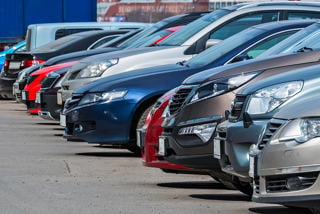By Dylan Setterfield, head of forecast strategy at Cap HPI
The used market for battery electric vehicles (BEVs) will likely remain highly complex for some time.
The high prices, which were fuelled by extremely strong demand in the middle section of last year, are a distant memory.
Increased used volume and many issues impacting demand combined to bring the ‘perfect storm’, resulting in eye-watering decreases in used values in recent months, with many models falling in value by 30% to 40%.
It was not a surprise that values came down. If anything, the most surprising element was just how long values had remained strong during 2022, but the speed of reduction was brutal.
In recent weeks, many models have continued to stabilise or increase slightly in value as the used market starts to normalise – overall, price reductions for BEVs at 36/60 in August were somewhat favourable to petrol and diesel, despite sold BEV volumes being almost double the level seen in August 2022.
Volume will continue to increase in the coming months, but many models already appear very attractively priced following the recent reductions, and we expect the rate of used car price falls to continue to slow.
Trade demand in the used marketplace is back to previous levels, and although some buyers remain selective, demand is considerably higher than it was a month or two ago and continuing to increase, especially for models at the lower end of the price spectrum.
On average, trade prices for most battery electric vehicles are now positioned below conventionally fuelled versions of the same model (where both fuel types are available). This is the case across all ages and by an average of -9.1% at 36/30.
Extreme variation in remarketing performance persists; it is still fairly common for the performance of individual BEV models against clean to vary between 80% and 120%.
Following the downward movement in prices, nearly new used values for almost all BEVs are now back below cost new, but some models still appear to have further to fall.
However, in some cases, a modest recovery in values and a realignment against ICE equivalents can be expected.
Supply and demand for BEVs will continue to wax and wane over the longer term. Still, electricity prices are expected to continue to reduce, consumers retain the desire to reduce emissions, and even in the minority of cases where there is a higher capital outlay, the cost of ownership situation will remain favourable under any sensible charging regime.
Despite recent criticisms of the expansion of the ULEZ in London, there is still the prospect of new clean air zones (most recently in Glasgow) and updates and extensions to the existing schemes, further fuelling demand for lower-emission vehicles.
There are signs that retail prices are now reflecting some of the reductions in trade prices as aged stock is disposed of, and these lower prices are also likely to stimulate consumer demand further.
The remainder of the market
Concerns about stock shortages have been replaced with concerns about excess supply, but the increased new and used car supply is still expected to be broadly matched with core demand from ‘needs purchasers’ (with these buyers less likely to generate a part exchange).
The ongoing cost-of-living squeeze is expected to continue to make itself felt for several more months, but many customers are buying out of necessity, and the economic situation impacts what they buy and not whether they make a purchase.
Interest rates are limiting retail consumer demand due to the cost of borrowing, with used car customers increasingly tending to be cash buyers, having secured cheaper funding outside of the retail network.
Those dealers offering deposit contributions and relatively low APR rates are seeing the benefit, and we expect this trend to continue.
Interest rates are also impacting dealer profitability due to increased holding costs, and many are expected to continue to run at stock levels considerably lower than they would have been historically, with vehicle values also remaining higher.
The re-pricing of aged stock is set to continue, and the cost-of-living squeeze will limit growth in demand. Increasingly, we expect dealers to be disposing of overage cars, either through auction or within the trade, as they cut their losses and focus on current market opportunities.
It is currently challenging to determine where the market will be in 12 months due to the increases in used car volume being delayed to such an extent that they start to merge into the period of reduced supply from lower new car registrations through the pandemic – we are now more than three years on from the first UK impacts of Covid-19.
Into 2024
Retail demand will remain constrained over the short term as the reality of the cost-of-living squeeze continues to make itself felt, and concerns remain over the impact of increasing interest rates on mortgage costs.
Used car volumes will continue to slowly increase in the coming months as fleets receive replacements for some long overdue vehicles.
For most sectors, short-term forecasts show modest adverse movements for the next few months, although in general, this remains slightly favourable to typical seasonality, with dealers continuing to pay good money for the best condition cars and those at an attractive price point for a quick retail sale.
The negative economic impact of any potential recession is expected to be outweighed by the reduction in used car supply already guaranteed by the lower new car registrations from the start of the pandemic onwards.
One-year-old vehicles will remain in relatively short supply for the foreseeable future.
However, despite the prolonged shortages of nearly new stock, the trend until recently had been for 3-year-old cars to outperform the 1- 1-year-old market, and they did not increase by as large a proportion.
Therefore, during the market adjustment, deflation is expected to be less than for 3-year-old cars.
Towards the end of 2023, we expect to see increasing levels of discounts and forced registration activity from the manufacturers, which will combine to restrain the typical positive start to the year in 2024 and limit the scope for used value increases, particularly on newer models and at younger vehicle ages.
As we move towards the final quarter of 2023 and onwards, we will start to see the positive impact of reduced used car supply as a result of more than 2.3 million fewer cars registered through the course of the pandemic, particularly from fleets.


















Login to comment
Comments
No comments have been made yet.